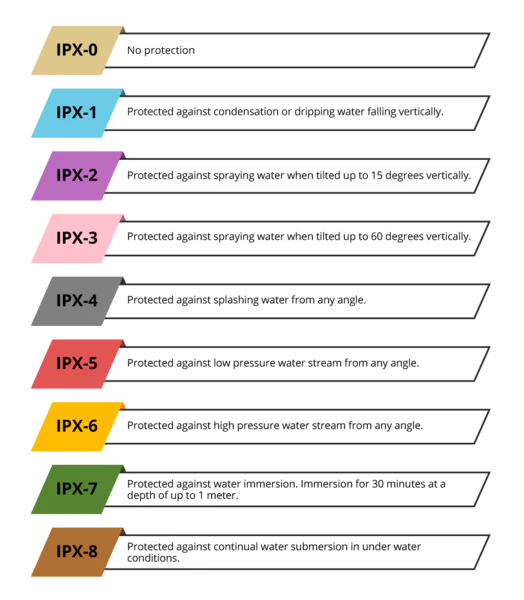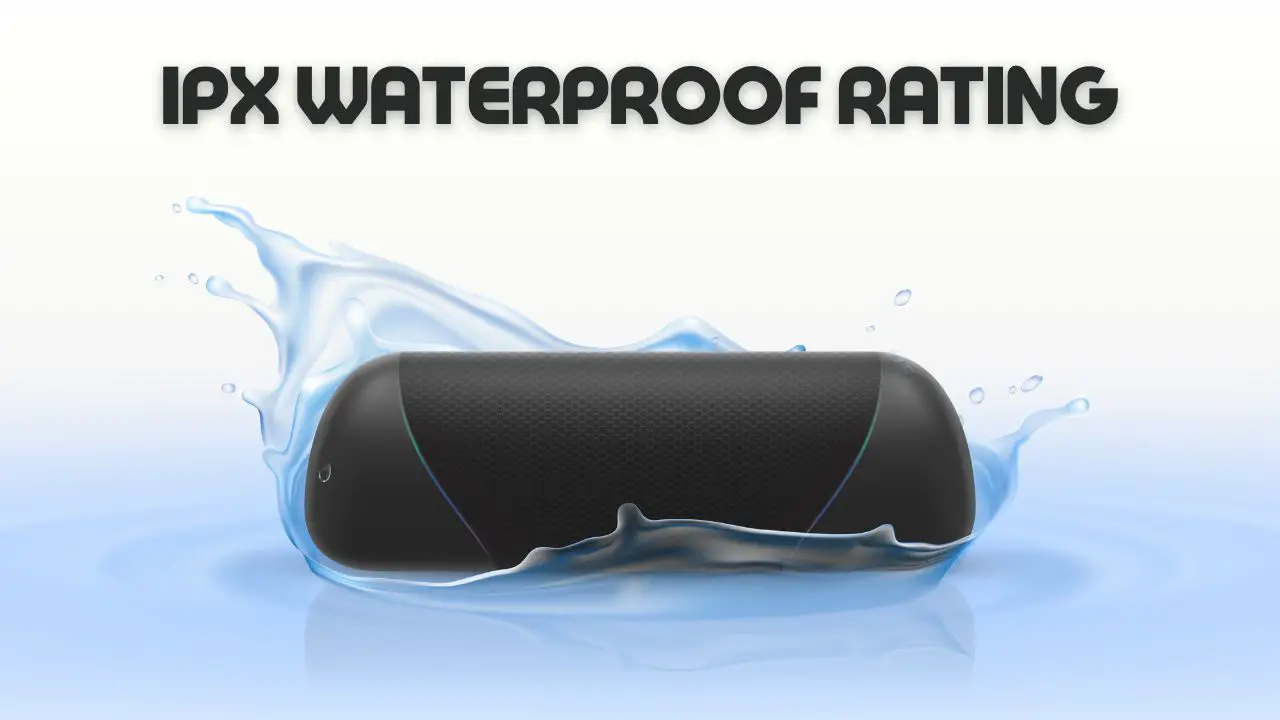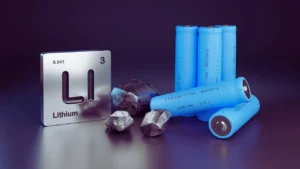We all know that we need to be careful with our electronics around water, but what does IPX mean and how do we protect our devices?
It seems like every other day there’s a headline story about someone dropping their phone in water and ruining it. And if you’re anything like me, you’re always worried about whether or not your device is waterproof.
Here at IPX Waterproof Rating, we want to make sure that you never have to worry about your device again. In this article, we’ll explain everything you need to know about the IPX waterproof rating system so that you can confidently protect your devices from water damage. So let’s dig down!
In This Article:
IPX Waterproof Rating
IPX Waterproof Rating is a system used to determine how water-resistant a product is. It is determined by testing the product in different ways and assigning it a number from 0 to 9.
What is IPX Waterproof Rating?
When it comes to water-resistant or waterproof devices, you’ll often see them rated with an IP code. IP stands for “ingress protection” or “international protection,” and it’s a numerical code that corresponds to how well a device is protected against dust and water.
The IPX Waterproof Rating system rates the waterproofing capabilities of electronic devices on a scale from 0-9. 0 means that the device is not at all waterproof, while 9 means that it is completely waterproof and temperature proof too.
What does it mean for a product to have a certain IPX Waterproof Rating? (IPX Waterproof Rating Guide)

The first digit of the IP code indicates the device’s level of protection against solids, and the second digit indicates the level of protection against liquids.
Here’s a quick rundown of what each digit means:
IPX- 0 = No protection
IPX- 1 = Protected against the water that drips vertically on the objects
IPX- 2 = Protected solid objects against water up to 15 degrees or less.
IPX- 3 = Protected the solid objects against water up to 60 degrees (e.g. tools and wires)
IPX- 4 = Protected against water sprayed from all directions (e.g. dust)
IPX- 5 = Protect against low-pressure water stream from any direction.
IPX- 6 = Protected against powerful water jets or high-pressure water streams from any direction.
IPX- 7 = Protected against short periods of immersion in water. i.e. to 30 mins in a depth of 1 meter.
IPX- 8 = Protected against long periods of immersion in water(Underwater)
IPX- 9 = Protected against high-pressure and high-temperature water
The higher the number, the better the protection. For example, an IPX4 rating means that the device is protected against splashing from all directions. However, an IPX7 rating means that the device can be submerged in up to 1 meter of water for up to 30 minutes.
Check Also: IPX7 vs IP67
Now that you know what the IP code means, you’re probably wondering how it’s relevant to you let’s see how to pick the ideal rating for you:
How to choose the most suitable rating for you?
After all, not many people roam around spraying their devices with water or taking them for a swim. But the truth is, even everyday activities like washing your hands or taking a shower can be enough to damage your device if it’s not properly protected. That’s why it’s so crucial to choose a device with the right IP rating for your needs.
For example, if you’re looking for a pair of headphones to use while working out, you’ll want to make sure they have an IPX7 rating or higher. This will ensure that they can withstand sweat, rain, and even being submerged in water without sustaining any damage.
On the other hand, if you’re looking for a set of speakers to use around the house, an IPX4 rating will probably be sufficient. This will protect them against splashes and light rain, but they won’t be able to withstand being submerged in water.
Of course, there are always exceptions to the rule. Some manufacturers may rate their products higher than they are, so it’s always a wise idea to do your research before making a purchase.
And that’s everything you need to know about IPX waterproof ratings! Now you’ll be able to choose the right device for your needs, whether you’re looking for something to use at the beach or just in your backyard.
Are there any products that don’t have an IPX Waterproof Rating?
Yes, some products don’t have an IPX Waterproof Rating. These products are not designed to be used in any situation where they may come into contact with water.
Most common ratings for devices?
Most devices fall somewhere in the middle, with a rating of 4 or 5 being the most common.
What are some common misconceptions about IPX Waterproof Rating?
- One common misconception about IPX Waterproof Rating is that a higher number means better waterproofing. Nevertheless, this is not always the case. For example, a device with an IPX4 rating is just as resistant to water as a device with an IPX7 rating. However, the latter can withstand being submerged in water for longer periods.
- Another common misconception is that all devices with a waterproof rating are completely waterproof. However, this is not always the case. Some devices may be resistant to water but not completely waterproof, so it is always wise to check the manufacturer’s specifications before using a device in or around water.
What are some tips for using devices with an IPX Waterproof Rating?
If you are using a device with an IPX Waterproof Rating, it is imperative to follow the manufacturer’s instructions carefully.
- Make sure that all ports and openings are properly sealed before using the device in or around the water. Avoid exposing the device to excessive amounts of water pressure or heat.
- It is also critical to remember that even devices with a high IPX Waterproof Rating can be damaged by water if they are not maintained properly.
- Always check for signs of damage after using a device in or around water, and make sure to dry it off completely before storing it.
- If you are ever in doubt about whether or not a device is safe to use in or around water, the advisable course of action is to contact the manufacturer for more information.
Final Thoughts
IPX waterproof ratings can help you avoid this issue altogether. By knowing what level of protection each rating offers, you can pick the right product for your needs. You can be confident that your device will stay safe in any situation.
We hope you found this article helpful in understanding IPX waterproof ratings. Remember, these ratings are designed to give you an idea of how well a device will withstand exposure to water, but they are not a guarantee of complete protection. Always use caution and follow the manufacturer’s instructions when using any device in or around the water.
Do you have any questions about IPX waterproof ratings that we didn’t cover in this article? Let us know in the comments below! Thanks for reading!
FAQs
What IPX rating shall I choose for my MP3?
Go for IPX4 means that the device is waterproof against splashing from any direction. This is the minimum level of waterproofing that is needed for most electronic devices and includes things like phones, MP3 players, and portable speakers.
What does IPX7 stand for?
IPX7 indicates that the gadget can withstand being submerged in water up to one meter deep for 30 minutes. This is a more robust level of waterproofing than IPX4 and is commonly found on devices like cameras and GPS systems.
What is the rating for underwater devices?
IPX8 is the highest level of waterproofing available and is often found on devices like diving watches and underwater cameras.





